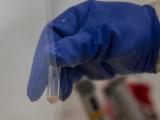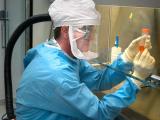Mar 25, 2003 (CIDRAP News) – Analysts who mathematically simulated the results of a major airborne anthrax attack say that very aggressive use of prophylactic antibiotics would be the key to preventing tens of thousands or hundreds of thousands of deaths after such an attack.
The analysts recommend either the pre-attack distribution of antibiotics or, if that is considered too risky because of the side effects and costs, rapid post-attack distribution by a large corps of volunteers.
In their report in the online edition of the Proceedings of the National Academy of Sciences, the analysts also recommend special anthrax-related training for nonemergency healthcare workers as an important defensive measure. Other measures, such as giving treatment priority to sympatomatic people and using sensors to detect airborne anthrax, would reduce the death toll by relatively modest amounts, they report.
"Our results underscore the need for the extremely aggressive and timely use of oral antibiotics by all asymptomatics in the exposure region, distributed either preattack or by nonprofessionals postattack, and the creation of surge capacity for supportive hospital care," the article states. It was written by Lawrence M. Wein of Stanford University, David L. Craft of the Massachusetts Institute of Technology, and Edward H. Kaplan of Yale University.
The complex model predicts that the release of about 1 kg of anthrax spores over an urban area of 10.8 million people would infect 1.49 million. Assuming a "mass service" treatment strategy, in which everyone seeking antibiotics or hospital treatment would be treated equally regardless of symptoms or age, the model predicts that 8.3% of those infected (123,400) would die of inhalational anthrax. The model assumes that the attack would spread anthrax spores over a region nearly 200 km long and several kilometers wide and that the public health response to the attack would begin 48 hours after the release.
The authors simulated the effects of sorting, or prioritizing, people for antibiotic or hospital treatment on the basis of their age and presence or absence of anthrax symptoms. They also looked at the effects of changes in six variables, such as the size of the area included in the emergency response, the numbers of antibiotic distributors and hospital care providers, and the efficacy of the drugs used.
The predicted death toll could be reduced almost 50% by eliminating the waiting time ("queueing") for receiving antibiotics, either by pre-attack distribution or by increasing the number of antibiotic distributors 7.5-fold, the report says. A much greater reduction in the death toll—to fewer than 300 people if patients were sorted by age or symptoms—could be achieved by eliminating waiting for hospital care. But this would require increasing the number of hospital workers trained to care for anthrax patients 75-fold, according to the model.
One way to improve hospital "surge capacity" would be to supplement hospital staffs with care providers drawn from the National Guard, the Public Health Service, the Red Cross, and other agencies, the article says. The model shows that deploying 2,800 of these "mobile servers" would cut the toll in half if patients were sorted according to symptom status and age, and using 8,500 extra personnel would reduce deaths by 90%.
The single step of sorting people for treatment according to symptom status and age, without other aggressive steps to reach people, would save relatively small numbers of lives, the report says. For example, treating symptomatic people first would reduce the death toll 4.3%. The further step of treating asymptomatic people over age 55 ahead of younger asymptomatic people would reduce deaths by another 2.8%, according to the model.
The analysis also simulated the use of "biosensors" to detect airborne anthrax spores, as in the BioWatch program recently announced by the Bush administration. "The development and deployment of modestly rapid and sensitive biosensors, while helpful," would yield "only second-order improvements," the article says.
The authors also recommend pre-attack anthrax vaccination of emergency responders to prevent a shortage of such personnel in case of an anthrax release. They add, "Serious consideration should be given to preattack mass vaccination should the probability of an attack loom sufficiently large."
In view of recently presented evidence about Iraq's development of anthrax weapons, the authors think the likelihood of an attack similar to the one envisioned in their model "has increased to a non-negligible level." Consequently, they state, "A concomitant increase in preparation to contain the consequences of such an attack is urgently required."
Wein LM, Craft DL, Kaplan EH. Emergency response to an anthrax attack. Proc Nat Acad Sci 2003;100(7) (early online edition) [Abstract]



















